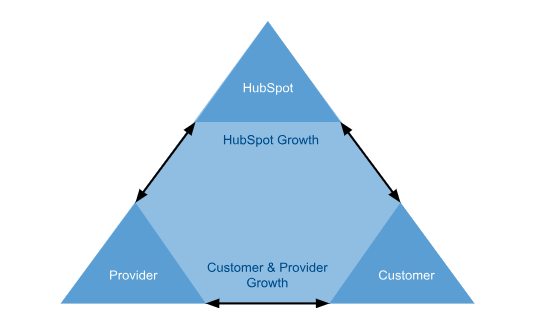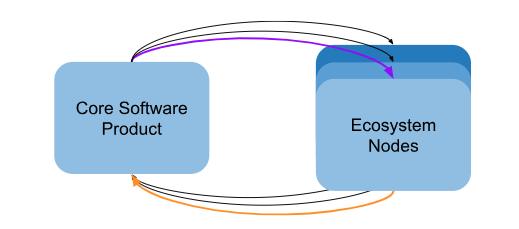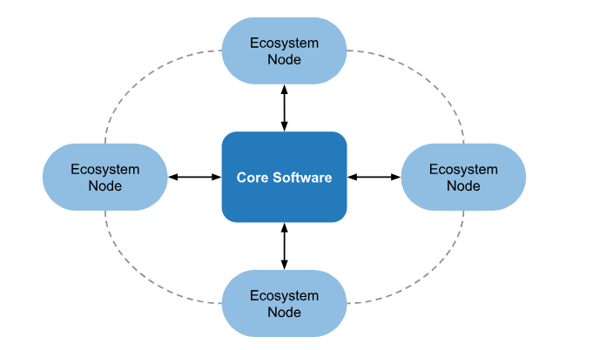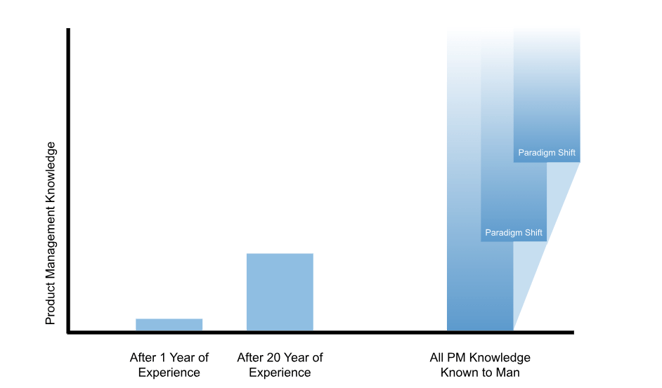Written by Eric Peters, Product Lead, Academy Product Group @ HubSpot
You probably clocked it - the above title was written with a GPT. 👆It was my favorite of the ten options generated for me. Like you, I am both cautiously optimistic and prudently aware of how much generative AI I should and could be weaving into my work in product at HubSpot, let alone the products my teams build. We are all racing to learn, finding miraculously novel yet somehow unoriginal ways to improve user experiences and drive business value, and doing our best to put the guardrails in place to keep those implementations on the good side of history.
This new AI-generated wave of technological learning opportunities feels similar to the wave of mobile advancement from a few decades ago. It started out with us all scrambling to make desktop UIs miniature, and then the mobile-first use-cases came. Remember when Uber was super affordable? I imagine today’s chatbots and automations will also be shadowed out by yet unforeseen use cases in the next few years (or months).
What I’ve learned throughout my career in tech is that it’s a learners game. We will always be students. Every product we work on, every user we offer that product to, and every technological or cultural shift those users experience, contribute to the wonderfully unique DNA in each product we build and how it evolves over time. I’ve quickly come to realize that there is no level eleven master of product management, only level eleven chameleons who can soak in their surroundings and perhaps not hide, but thrive by adapting to new variables in their work.
If you share this mindset, and particularly if you inspire it, Ecosystem Product Management may be a great fit for you. The puzzles we solve in software ecosystems are complex to work through, yet fulfilling to solve. While much of this post describes the nuances and complexity of building an ecosystem, every challenge we face is an opportunity to make you a more skillful PM.
As the product management career path has gotten more complex, specializations have developed that I think are interesting to study. I think a lot about how people learn and develop skills, and how those skills drive careers. I'm a fervent believer in the ‘always a student’ mindset. I’ve had the opportunity to study under incredible product leaders here at HubSpot. I started out on HubSpot’s Growth team with VP of Product, Chris Miller, after spending four years growing HubSpot Academy ~20x as an acquisition channel and strategic moat for HubSpot. (At some point our metaphors went from medieval defense systems to biological communities.)
As HubSpot Academy evolved into a two-sided marketplace, I joined VP of Product, Michael Walton’s team in HubSpot’s Ecosystem Product Line, EVP of Product, Andy Pitre building Connect.com, SVP of Product, Karen Ng, and finally VP of Product, Brian Gorbett. All of these leaders have had incredible careers working on prolific products that not only impacted companies, but shifted industries. The opportunity to learn from them is unreal, and the opportunity to condense just a few of those learnings into six bullet points below is likely a futile challenge. Nevertheless, with help from my colleagues in Ecosystem Product Management at HubSpot, I’ve mapped out below what I consider some of the unique challenges facing Ecosystem PMs.
What It Means To Be An Ecosystem PM: 6 Unique Challenges and How to Overcome Them
(👆There were no good options for generating this one.)
1. Supply-Side Personas
Let’s start with one of the more straight-forward aspects of working on a node in a B2B SaaS company’s ecosystem: marketplace dynamics. Ecosystem Product Managers typically have multiple levels of users to influence - in other words, they have to impact the end user by building products for someone else. While traditional B2B SaaS PMs might build for customers who then have an impact on their end user, Ecosystem PMs build for a partner that then enables a customer to have impact on their end user.
For example, in HubSpot Academy we’re building tools for a course creator to publish their course, which is then viewed by a user. That user then goes and applies that knowledge which ultimately impacts their business, or the customer of their business. Is the true customer the customer of our customer? Or the course creator? It turns out, both have to be accounted for, researched, interviewed, and understood, to make HubSpot Academy add value to HubSpot’s ecosystem.What about the partners who develop applications that are published in HubSpot’s App Marketplace? Enabling them to build the applications and publish them is just step one. Enabling HubSpot customers to find and install them is step two. Creating better customer experiences for the customers of those HubSpot customers, through the use of those apps and integrations, is step three.

The addition of a supply-side persona adds another layer of complexity to the Ecosystem PM’s world. This persona tends to be particularly opinionated seeing as their livelihood might partially depend on you, which can be incredibly helpful. Your listening and feedback mechanisms should be set up to take in as much feedback as possible, using that feedback to spur qualitative user interviews, which then generate insights that can be validated with quantitative research.
Understanding these user types, what makes them tick, and especially what they know about and think of each other, is a unique research challenge for Ecosystem PMs. In most cases, we’re building a platform that will be wielded by more than one user type in various ways to generate value for more than one user type.
2. Wide Spectrum of User Personas
A clear representation and understanding of the user is one of the most basic requirements for any product team. Product market fit fully depends on an understanding of the market, afterall. The more subcategories and gradation of that user persona, the less clear your product market fit is, and the more foggy product requirements and priorities get. I’ve noticed that ecosystem products tend to be more susceptible to this, and it requires a determined Ecosystem PM working with conviction to clearly define the highest priority persona for their team, without sacrificing inclusivity. Not only do they have to understand the various personas, as mentioned above, but they have to be able to prioritize them. Speaking to these personas regularly, and bringing them along for the journey, can be a great mechanism for understanding their needs and tying them back to business outcomes.
Let’s look at Connect.com for example - HubSpot’s platform for connecting users and enabling them to join community groups and learn from each other. The potential target audience for this product is so incredibly broad: “anyone who wants to connect.” They could offer discussion spaces for developers, solution partners, small business users, enterprise users, job seekers, freelancers and any number of other segments of people in the HubSpot ecosystem. Developers might ask for a way to post code snippets. Partners might ask to share workflow templates. Job seekers might ask for a formal job application process. To combat this, the team has to focus on specific ‘atomic communities’ that they want to focus on first, learn from, build for, and expand from there.
An experienced Ecosystem PM will understand the information flow into their team, and figure out how to make sure their team is addressing the information that results in the highest user and business value for their product. We can take some of our basic prioritization frameworks like pain x volume or RICE (reach, impact, confidence, effort) and apply them to personas, rather than features, to help us see the heat map of where to place our bets. The trick is to focus on the personas that will result in the most value to the ecosystem, and therein the business - but again, without sacrificing inclusivity!
3. Irregular User Flows
My time spent on the HubSpot’s growth team was an incredible education on measurement, conversion rate optimization, and experimentation. That team spends weeks zeroing in on the right hypothesis to test, how they’d carefully design an experiment to test it, and how they’d build a plan to put its results into action. This amount of experiment overhead is worth every minute when you’re optimizing some of the most valuable conversion rates at HubSpot: signups, activation, purchases, upgrades, etc.
As the PM for HubSpot Academy, which was effectively a platform that drove a ton of signups for HubSpot, our conversion points were a little less clear. Sure, we wanted signups, but we also wanted some of those signups to find out about the software related to the topics they were learning, and hopefully purchase that software. Yes, believe it or not, a lot of our new users sign up for HubSpot Academy without realizing HubSpot even offers software. Not only do we teach them about Content Marketing (theoretical training), but we teach them the tools that come in their account that could help them with their content marketing (technical training), and which ones they could pay for to help them even more.
At the same time, we didn’t want to ‘sell’ the software too hard into the Academy user experience, because well - our whole brand and the topic of much of our content was to be helpful, not overtly promotional. Philosophically, enable free access to MBA level education around the world is a huge motivator for the team. In fact, many of our new users are simply not a great fit for our software, and to this day, we are very okay with that.
Where there is a predictable percentage of signups for HubSpot’s CRM that will upgrade within 90 days of signing up, HubSpot Academy’s new users might take years to monetize. Students who were assigned a certification course in college become interns, then marketing managers, and years later finally have the budget to influence the purchase of HubSpot. Those seeds were planted years ago, and it’s exciting to see them flower. In many instances, Ecosystem PMs are balancing having an impact today, and planting seeds for the future. Vision building, therefore, is another uniquely valuable skill for these product managers to learn.
Navigation between ecosystem products and core software products tends to be a unique challenge. When is the appropriate time to show the ecosystem to a software user - will it be overwhelming? When is the appropriate time to show the software to an ecosystem user? Will it be appreciated?

We tend to think of these flows as highways, both of which can be optimized, but that require additional work and focus beyond just building the core ecosystem node. Do I spend my team’s capacity on building up HubSpot Academy as a platform, or do I spend it on getting people from HubSpot to HubSpot Academy, or HubSpot Academy to HubSpot. In a perfect world, I would have a growth team dedicated to the two highways, and an ecosystem/platform team dedicated to the platform. Unfortunately, or perhaps fortunately, that lack of capacity is a forcing function on us to prioritize ruthlessly and do everything we can to research these priorities and place the most informed bets we can.
4. Unique Tech Challenges
Large tech companies tend to build software platforms that enable autonomous product teams to develop software quickly and consistently. You can think of HubSpot like a city of apps, where each building is a unique application that uses the same public infrastructure and the same building codes. Much like the ‘broad user personas’ situation I described earlier when building a platform, our HubSpot infrastructure platform teams have a similar problem of primarily supporting our core software but also flexing to support our sometimes unusual ecosystem needs. Sometimes we need to build a cruise terminal in HubSpot City, afterall.
Let’s take recommendation engines for example. There aren’t many places in our core product where we need to make ML-based recommendations to users based on a broad set of factors that take into account all global users. In both HubSpot Academy, and the HubSpot Marketplaces, it’s a relatively basic feature to offer recommendations to users based on other users, or based on interactions with the software. Along those same lines, most HubSpot data (from the user’s perspective) is split up into accounts, with good reason - you only want people working at your company to have access to your CRM data. But what if we want to make recommendations based on Academy usage data for all of our global users, and not just those in your account. In this case, we find ourselves thinking much more about users, and less about accounts.
In HubSpot Academy, the relationship between our user and their learning platform is about 85% ‘personal’ and 15% ‘business’ depending on how their company uses HubSpot Academy. In other words, a user will primarily think of HubSpot Academy as their online learning platform, where they’ll think of HubSpot CRM as their company’s CRM. This single difference in perception of ownership unleashes a whole host of tech puzzles for our product teams. What happens when users move between companies? Are the user’s credentials legally company data or personal data? Does the user expect other people in their account to see their exam results?
A lot of time is spent designing and building unsupported functionality on a software development platform that was built for a core product and not its ecosystem nodes. It takes patience and relationship-building skills to work with platform infrastructure teams to explain why you’re building what you’re building, and ultimately why the platform might need to flex for your team. For engineers, unique tech challenges tend to mean research and brainstorming ways to overcome those challenges. For product managers, unique tech challenges tend to mean cross-functional collaboration and distilling the value in building something hard that makes it worth the cost.
5. Navigating the Ecosystem
Ecosystem nodes can sometimes work together to create user experiences that are more valuable than the sum of their parts. Knowing when and how to make these collabs work takes a deep understanding of the user’s perspective. As product managers, our perspective can sometimes cloud our judgment about how our users perceive the core software product and its ecosystem. At HubSpot, where all of our ecosystem product teams are organized together in one product line, it’s easy to think that user’s experience “the ecosystem” as one thing - but the truth is, all of our nodes are floating off in space millions of miles away from each other, and artificially connecting them could result in more ‘showing our org chart’ than we’d like.
That’s not to say that there aren’t great opportunities for ecosystem teams to collaborate. Users learning about HubSpot integrations in Academy. Users joining discussion groups on Connect.com about topics they’re learning about. These are great use cases and partnerships we’ve had between ecosystem product teams at HubSpot. It’s also helpful and efficient to group these teams together because they share a lot of the unique problems and complexities that I’ve described so far. That said, by the very nature of our product teams being in the same product line, there is an underlying sense of vision building ‘for the ecosystem’ that happens, resulting in an attempt to weave ecosystem products to each other, rather than to the core product. In my experience, the wagon wheel approach is more appropriate.

Each arrow and dotted line in the above diagram represents a collaboration with another team, and that’s in addition to the business-side counterpart that most ecosystem nodes already have. Every cross-team collaboration, while they can be some of the most interesting and fulfilling product endeavors, requires careful planning and negotiation. Some of the most successful ecosystem product managers at HubSpot are those that somehow figure out a way to sit at the same side of the table with other product managers, and figure out how to align goals and timelines in a way that ultimately solves for their shared users.
6. Attributing Value
What’s the value of a minute of HubSpot Academy watched? What’s the value of an integration installed? What’s the value of a developer publishing their app? Value attribution, perhaps the most fundamental tool in a product manager's tool belt for prioritizing features and growing their scope, doesn’t come very easily in ecosystem products. For example, I can tell you that Marketing Hub Pro customers who self-educate in HubSpot Academy have a significantly higher customer dollar retention, but the age old causation vs correlation question still exists: do good customers self-educate, or are self-educators good customers?
Attributing value to an ecosystem node isn’t impossible, but it does take a deep understanding of how the product impacts the business through not only its users, but also the aforementioned supply-side personas who wield value from it. It also takes the ability to condense that understanding into a one-sentence, memorable and shareable narrative that holds up against core-product investment decisions. All of the previously mentioned challenges can erode confidence in ecosystem bets. They might take longer to play out. They might ignore secondary personas. They might make assumptions about what technology we have, or will have. They may depend entirely on a supply-side stakeholder using the technology you built, the way you planned for them to.
Keeping it simple, crystalizing your value statements and seeing the world from your audience's perspective, are helpful in these conversations. Ecosystem PMs have to know the benefit of investing in an ecosystem, and the cost of not investing in an ecosystem. Garnering buy-in from executive stakeholders using a combination of qualitative and quantitative data is a given, but it’s unlikely these teams will be rich in engineering capacity compared to their core-software counterparts.
To this I would say that scarcity breeds innovation and organization. With limited capacity, our teams have fine-tuned operating systems that enable them to deliver value rapidly and predictably with twenty people that might compete with a 200 person engineering team at a company where being an online course provider is their core objective. It’s not for the faint of heart, but it is an incredibly educational environment for a product manager to hone their skills.
Always a Student
In many ways, the ultimate skill in the tech industry is to be able to adapt alongside it. Artificial intelligence is the current wave, and I can only imagine what the next one will be. Early in your career, it makes sense to go broad and try a lot of things, to see what puzzles get you excited. Maybe you’ve landed on product management, and then realized that within product management, you can still go pretty broad and try a lot of things. Then maybe you specialize in ecosystem product management, and once again you realize you can go pretty broad on a lot of things within ecosystem product management. The longer you’ve been doing this, the more specialization you realize there is - it just takes some time to learn the taxonomy.
If you want to accelerate your skill development, try something new, and learn how to build products that offer unique challenges and unique value to the world, give SaaS ecosystem products a try - you won’t regret it.
Are you ready to make an impact? Check out our careers page for your next opportunity! And to learn more about our culture, follow us on Instagram @HubSpotLife.

